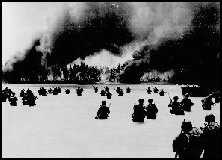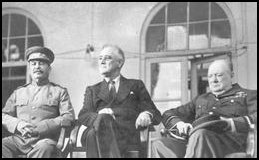 Marines wade ashore at Tarawa |
Project 60: A Day-by-Day Diary of WWII
Remembering the First Fight Against Fascism |
 The "Big Three" at Tehran |
 Marines wade ashore at Tarawa |
Project 60: A Day-by-Day Diary of WWII
Remembering the First Fight Against Fascism |
 The "Big Three" at Tehran |
Germany's dream of developing an atom
bomb comes to an end as 160 US heavy bombers hit the hydro-electric plant at
Vermork, Norway. Twenty civilians were killed in the attack which missed the
plant. However, the damage done to the rest of the facility was so severe that
the Germans abandoned further production of "heavy water". After five desperate days of fighting,
the bulk of the British survivors of the 234th Brigade surrender to
the Germans on Leros, ending effective resistance on the island. The Germans
took 3500 British soldiers prisoner along with nearly 6000 Italians who did not
participate in the battle. Soviet forces continue to advance toward Gomel in the north and Korosten in the south. German counterattacks south of Zhitomir succeed in breaking the Soviet lines at several points. Under the cover of the long European
winter nights, British Bomber Command is ready to unleash deep penetration raids
into Germany. Harris opens his attacks with a 440 bomber raid on Berlin,
dropping 700 tons of ordnance on the city. Despite heavy cloud cover, nearly 150
civilians were killed in the terror bombing. Fighting on the eastern front remains
heavy west of Kiev as Korosten and Ovruch are captured by the Soviets. Meanwhile
German attacks south of Zhitomir continue to make progress. To the north, the
rail line out of Gomel to the west is cut as the Red Army captures Rechitsa. The 3000 ton British freighter Penolver stuck a mine off Newfoundland. Within minutes, 14 of her crew were rescued by the US merchantman De Lisle, which shortly thereafter struck a mine and was sunk. The German forces enter Zhitomir and
heavy street fighting results. The Soviets, realizing how exposed their position
is against this strong thrust made limited and organized retreats to more
defensible lines while continuing their attacks west of Kiev. The US navy launches major air raids
against the Gilbert Islands. The planes from 11 aircraft carriers hit Tarawa,
Makin and Nauru islands. November 20, 1943 Gilbert Islands Invaded
- Elements of the 2nd Marine Division under General J.C. Smith land
on the Tarawa Atoll. The attack is supported by gun fire from three battleships,
four cruisers and aircraft from 3 aircraft carriers. Despite the massive
firepower, the landings are a fiasco. As the landing craft and amphtracks
approached the beach, they came to a stop 500 yards from landfall when a
previously undiscovered reef was struck. The amphtracks could climb the reef
only with difficulty and the landing craft disgorged its infantry in the waste
deep water. The Japanese then opened up on the defenseless Marines. Most of the
first wave was wiped out. Successive waves piled in behind the wreckage of the
previous one. By nightfall, the marine beachhead was 100 yards wide and 20 feet
deep. Of the 5000 men engaged 1500 were dead or wounded. A simultaneous landing was made on
Makin Atoll by elements of the US 27th Infantry Division commanded by
General R. C. Smith. Fire from four battleships, four cruisers and aircraft from
3 carriers supported these landings. The landings are made against stiff
opposition but casualties and confusion are not as great as at Tarawa. Elsewhere Soviet forces opened a new offensive
across the Dniepr River near Cherkassy, south of Kiev. With the loss of Leros, British forces begin a hasty withdrawal from the exposed Aegean island of Samos. The 2nd Marine Division makes
additional landings against very heavy resistance at Tarawa Atoll. Casualties
are very heavy. Of the 800 men landed, 450 became casualties. After a day of
very heavy fighting, the marines established an improved, but still not secure
position and the Japanese were exhausted. Admiral Shibasaki, the Japanese
commander radioed Tokyo, "Our
weapons have been destroyed. From now on everyone is attempting a final charge.
May Japan exist for ten thousand years!" Elements of the US 27th
Infantry Division successfully established their beachhead at Makin Atoll and
advanced to clear the island. November 22, 1943 After heavy fighting and serious
losses, 2nd Marine Division establishes a secure bridgehead on Tarawa
Atoll and begins advancing to clear the island. At dusk, the Japanese sent in a
final suicide charge which nearly overran B company, 6th Marine
Regiment. On Makin Atoll, most of the island is
cleared by midnight. The British 8th Army
assaults the Sangro River line establishing a very limited bridgehead 5 miles
wide and a little over a mile deep. The position is made especially tenuous as
heavy rains have made it difficult to reinforce and supply the position. Tarawa Atoll is cleared of enemy troops
by noon. Both sides have suffered heavily as the Japanese garrison of 4836 men
are utterly destroyed. Less than 100 survived and most of those were foreign
workers. The Marines lost 3283 men, including 1090 dead. The butcher's bill
from Makin was less but still severe. The Japanese garrison of 600 was destroyed
at a loss of 200 dead and wounded by the US infantry. A test flight of the first true jet
fighter aircraft, the Me-262 is made for Hitler. Hitler inexplicably declared
that the plane must be capable of carrying bombs. This incredible order would
delay deployment for a critical year. This remarkable aircraft could have
potentially turned the tide of the air war over German in favor of the Nazis had
it gone into production. The US Navy lost the escort carrier Liscomb
Bay and 600 hands perished when she sunk. Japanese forces in the Solomon Islands
launch a counterattack against the Marines at Bougainville. The attack is
shredded to pieces. Bombers from the US 14th Air
Force based in China, hit Shinchiku airfield on Japanese held Formosa destroying
42 Japanese planes on the ground and in aerial combat. Red Army forces capture Gomel. A German glider bomb hits and sinks a
British troop transport off Bougie, Italy killing more than 1000 men on board. The British 8th Army consolidates its bridgehead over the Sangro River by crossing an armored brigade. The British 8th Army launches another attack across the Sangro River. The attack was spearheaded by the Indian 8th Division and heavily supported by artillery and air assets. The German 65th Infantry division defending the area took heavy losses and withdrew in disorder before German reinforcements restored the situation. Stalin, Churchill and Roosevelt meet for the first time in person as the Teheran Conference begins.The British 8th Army
continues its attacks along the Sangro River, capturing Mozxzogrogna. Australian forces capture Gusika and
Bonga in New Guinea. The British 8th Army continues its attacks along the Sangro River, capturing Fossacesia. They also succeed in clearing the line of ridges north of the river denying the Germans positions to observe and bring down fire on the British bridgeheads. The Teheran Conference ends between
Stalin, Roosevelt and Churchill. The "big three" agree to the invasion of
northern France in May 1944, a second invasion in southern France some time
later, and Russia joining the war against Japan once Germany was defeated. The German attacks in the Zhitomir area
intensify forcing the Soviets to withdraw from Korosten. The Teheran Conference ends between
Stalin, Roosevelt and Churchill. The "big three" agree to the invasion of
northern France in May 1944, a second invasion in southern France some time
later, and Russia joining the war against Japan once Germany was defeated. The German attacks in the Zhitomir area
intensify forcing the Soviets to withdraw from Korosten. The Teheran Conference ends between
Stalin, Roosevelt and Churchill. The "big three" agree to the invasion of
northern France in May 1944, a second invasion in southern France some time
later, and Russia joining the war against Japan once Germany was defeated. The German attacks in the Zhitomir area
intensify forcing the Soviets to withdraw from Korosten. German positions in the Gomel area
crumble as Red Army forces capture Dovsk and move toward Rogachev. The German 17th Army,
isolated on the Crimean peninsula, launch desperate attacks against Soviet
beachheads around Kerch. Tito's sets up a provisional
government in Yugoslavia. The US submarine Sailfish,
patrolling in the Japanese home waters, sinks the escort carrier Chuyo. Operation Crossbow, the effort to bomb
the V-1 launch sites along the French coast, begins. The British 10th Corps (US 5th
Army) is engaged in heavy fighting around the summit of Monte Camino. December 6, 1943 Konev's forces continue to advance in
the Ukraine as the Red Army takes Znamenka, cutting the rail line to Smela. 1941 Archive: 1942 Archive: 1943 Archive: Special Editions: Editor's Corner Archive: Hitler's Angle "The story of Prescott Bush and his association with the Nazis begins just before the end of World War I..." The Past Through Tomorrow "It is quite frightening to realize just how similar our nation's actions have been and appear to be heading when compared this way..." Afghanistan and Vietnam: When the "war against terrorism" began, many knowledgeable people warned that our operations in Afghanistan would turn into another Vietnam. Want to Win - Think Before You Lash Out - "If we are serious about taking the war to the enemy, it is time to look ..." The First Fight Against Fascism - We must remember the Spanish Civil War also. Arguing Victory - "... Each nation who fought against fascist tyranny in WWII brought with it part of whole needed to defeat that evil..." War, Glory, Honor and Remembrance - "War is a brutal and savage insult on human society..." The First
Casualty... in time of war, those in power are even more inclined to
hide the truth, since that truth is often manifest in the most gruesome and
terrible acts. Those wishing to contribute items. stories or comments should contact D.A. Friedrichs |